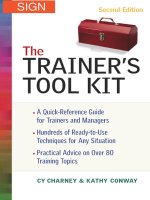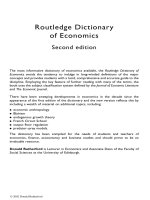Routledge Dictionary of Economics Second edition phần 1 potx
Bạn đang xem bản rút gọn của tài liệu. Xem và tải ngay bản đầy đủ của tài liệu tại đây (541.36 KB, 70 trang )
Routledge Dictionary
of Economics
Second edition
The most informative dictionary of economics available, the Routledge Dictionary of
Economics avoids the tendency to indulge in long-winded definitions of the major
concepts and provides students with a lucid, comprehensive and accurate guide to the
discipline. Employing the key feature of further reading with many of the terms, the
book uses the subject classification system defined by the Journal of Economic Literature
and The Economic Journal.
There have been sweeping developments in economics in the decade since the
appearance of the first edition of the dictionary and the new version reflects this by
including a wealth of material on additional topics, including:
. economic anthropology
. Blairism
. endogenous growth theory
. French Circuit School
. output floor regulation
. predator–prey models.
The dictionary has been compiled for the needs of students and teachers of
economics, finance, accountancy and business studies and should prove to be an
invaluable resource.
Donald Rutherford is Lecturer in Economics and Associate Dean of the Faculty of
Social Sciences at the University of Edinburgh.
© 2002 Donald Rutherford
Routledge
Dictionary of
Economics
Second edition
Donald Rutherford
London and New York
© 2002 Donald Rutherford
First published in 1992 as the Dictionary of Economics
Second edition published 2002
by Routledge
11 New Fetter Lane, London EC4P 4EE
Simultaneously published in the USA and Canada
by Routledge
29 West 35th Street, New York, NY 10001
Routledge is an imprint of the Taylor & Francis Group
# 2002 Donald Rutherford
All rights reserved. No part of this book may be reprinted or
reproduced or utilised in any form or by any electronic,
mechanical, or other means, now known or hereafter
invented, including photocopying and recording, or in any
information storage or retrieval system, without permission in
writing from the publishers.
British Library Cataloguing in Publication Data
A catalogue record for this book is available from the British
Library
Library of Congress Cataloging-in-Publication Data
A catalog record for this book has been requested
ISBN 0–415–25090–0 (hbk)
ISBN 0–415–25091–9 (pbk)
This edition published in the Taylor & Francis e-Library, 2005.
“To purchase your own copy of this or any of Taylor & Francis or Routledge’s
collection of thousands of eBooks please go to www.eBookstore.tandf.co.uk.”
ISBN 0-203-00054-4 Master e-book ISBN
© 2002 Donald Rutherford
Contents
Preface to the first edition
Preface to the second edition
List of abbreviations
DICTIONARY OF ECONOMICS
Appendices
Subject classifications
© 2002 Donald Rutherford
Preface to the first edition
Economics, the Queen of the Social Sciences, has now established itself as a major
subject in dialogue with the physical sciences, law and the arts. There are few
aspects of human behaviour that do not have an economic dimension and little of
current affairs can be understood without a knowledge of economic principles. It
is, therefore, not surprising that it is a major discipline in schools, colleges and
universities throughout the world, studied by millions and the topic of
conversation of millions more.
The Routledge Dictionary of Economics has as its concerns as many issues as the
subject Economics now covers. The breadth can be appreciated by considering the
subject classifications used by the Journal of Economic Literature (USA) and The
Economic Journal (UK). The related specialties of economic history, commercial
law, and econometric and statistical techniques are all within its ambit. However,
to prevent a subject dictionary becoming encyclopedic, a lexicographer can follow
the useful conventions of taking from sister disciplines only what is regularly used
in mainstream economic literature. For example, from law, it is customary to
emphasize competition, fiscal and banking law more than constitution al or
criminal law. This interpretation of economics in the broad sense makes a
dictionary of this kind more of a dictionary for economists, rather than a
dictionary of economics with terms peculiar to the subject.
Even if a dictionary takes a broad view of its subject matter, it is usually
addressed to a particular audience, such as first-year undergraduates. This is an
approach that I have wanted to avoid, as there is a substantial heterogeneity of
economics courses and students often need to research some areas of the subject in
more depth than others. Also, it can be patronizing to the general reader to regard
all of his or her knowledge to date as rudimentary. Even the reader of the daily
newspapers who never looks at an economics textbook will encounter the most
complex of ideas, chaos theory for example.
To produce a dictionary of this kind, I started with an assortment of basic
textbooks and many current newspapers and journals. I soon discovered that
about a thousand concepts are common to all the textbooks, for example notions
of cost, economic systems and banking. From general textbooks I moved to a
© 2002 Donald Rutherford
perusal of specialist books on the diverse divisions of the subject. The areas of
economics encompassed obviously have to reflect current concerns; m any
environmental concepts are included and the ‘male’ character of many economics
works has been partially avoided by including biographies of several leading
female economists. Newspapers and journals provide a modern guide to current
economic discourse. There is no foreseeable end to the creation of economic
neologisms – major events such as the deregulation of financial markets and the
political developments in Eastern Europe, which have changed the nature of many
economies, have produced an expansion of new terms. Some terminology is
ephemeral but many words that start as slang, such as ‘yuppy’, have a surprising
longevity. I have taken the optimistic view that numerous catchwords and
catchphrases will render linguistic service for many years.
The entries in this Dictionary are sequenced alphabetic ally letter by letter: for
example, discounted share price precedes discount house, which precede discounting.
The standard form for each item included begins with a headword followed by one
or more single letter and number codes to indicate the branch or branches of
economics that most frequently use that term. As it is important to ensure that all
entries are immediately comprehensible and independent of the others, the text of
each entry begins with a short definition before any discussion is included. Where
related entries can profitably be read in conjunction, reference is made to them.
Standard diagrams are included in the entries that require them. For the longer or
more difficult entries, references to other works that either indicate the original use
of that idea or provide a modern discussion of it are given.
A dictionary is a solace for the perplexed, a guide for the scholar and a map of a
new terrain for the general reader. I hope that this Routledge Dictionary of
Economics is all of these.
© 2002 Donald Rutherford
Preface to the second edition
Ten years have elapsed since the first edition of this Dictionary. The vocabulary of
economics in the broadest sense has considerably grown. Many neologisms have
sprung from continued changes in national economies, not least the innovations in
financial markets and growing concerns about the environment. Institutional
changes, for example, the coming of the World Trade Organisation, and new
interests in economic thought, not least through the further awards of Nobel
Prizes for Economics, have inspired new entries. Inevitably some terms in the first
edition have not been as durable as others and recommended reading needed
revision.
Extensive reading of economics journals and monographs, as well as
newspapers, has produced over a thousand new entries. The organisation of the
Dictionary has also been changed. The newer version of the subject classification
employed by the Jo urnal of Economic Literature and The Economic Journal has
been applied to previous and new entries. There is now a separate listing of
abbreviations and acronyms, together with tables for currencies and stock market
indexes.
Without the resources of major libraries this new edition could not have been
undertaken. I am grateful for having access to Edinburgh University Library,
Cambridge University Library, and to the Economics Library and Bodleian
Library of Oxford University. Colleagues and friends have been very supportive.
In particular I would like to mention Graham Richardson, Stuart Sayer, John
Gordon and Gillian Gordon.
© 2002 Donald Rutherford
Abbreviations
AARCH augmented autoregressive conditional heteroscedasticity
AC advanced country
ACAS Advisory, Conciliation and Arbitration Service
ACH automated clearinghouse
ACM Andean Common Market; Arab Common Market
ACP African, Caribbean and Pacific
ACRS Accelerated Cost Recovery System
ACT advanced corporation tax
AD anti-dumping
AD–AS aggregate demand–aggregate supp ly
ADB Asian Development Bank
ADR American Depository Receipt
AEA American Economic Association
AESOP all-employee share ownership plan (UK)
AFBD Association of Futures Brokers and Dealers (London)
AfDB African Development Bank
AFDC Aid to Families with Dependent Children
AFL–CIO American Federation of Labor and Congress of Industrial
Organizations
AG Aktiengesellschaft
AGM Annual General Meeting
AGNP augmented gross national product
AIBD Association of International Bond Dealers
AIM Alternative Investment Market (London)
ALC Australian Loan Counci l
ALM asset-liability management
AMEX American Stock Exchange
AMU Arab Maghreb Union
ANOVA analysis of variance
AOSIS Alliance of Small Island States
APACS Association for Payment Clearing Services
© 2002 Donald Rutherford
APB Accounting Principles Board (UK)
APC average propensity to consume
APCIMS Association of Private Client Investment Managers and Stock-
brokers
APR average percentage rate (of interest)
ARCH autoregressive conditional heteroscedasticity
Ariel Automated Real-time Investment Exchange
ARIMA autoregressive integrated moving average
ARM adjustable rate mortgage
ARMA autoregressive moving average
ASEAN Association of South East Asian Nations
ATM automated teller machine; air transport movement
ATP Aid and Trade Provisions
ATS automatic transfer from a savings account; automatic transfer
service account
BACS Banks Automated Clearing System (UK)
BAT best available technology
BCEAO Banque Central e des Etats de l’A frique de l’Ouest (Central Bank
of West African States)
b/d barrels per day
BDI Bundesverrand der deutschen Industrie
BDR British Depository Receipt
BEA Bureau of Economic Analysis (USA)
BERD La banque europe
´
enne pour la reconstruction et la de
´
veloppe-
ment (European Bank for Reconstruction and Development)
BIDS British Institute of Dealers in Securities
BIS Bank for International Settlements
BNB basic needs budget
BOF Balance for Official Financing
BOY beginning of the year (or of an accounting period)
bp base points (of an interest rate)
BP balance of payments
BRITE Basic research in industrial technologies for Europe
C aggregate consumption
C-20 Committee of Twenty
CA confluence analysis; chartered accountant
CAC Central Arbitration Committee; Consumer Advisory Council
(USA)
CACM Central American Common Market
CAP Common Agricultural Policy
CAPM capital asset pricing model
CAR compounded annual rate (of interest)
CARICOM Caribbean Community
© 2002 Donald Rutherford
CARIFTA Caribbean Free Trade Area
CAT Charges, Access, Terms
CATS Computer-assisted Trading System
CBD central business district (of a city)
CBI Caribbean Basin Initiative; Confederation of British Industry
CBO Congressional Budget Office (USA)
CBOE Chicago Board Options Exchange
CC Competition Commission (UK)
CCC Commodity Credit Corporation (USA); Competition and Credit
Control (UK)
CCT compensating common tariff; compulsory competitive tendering
CD Certificate of Deposit
CDB Caribbean Development Bank
CEA Council of Econom ic Advisers
CEAO Communaute
´
Economique de l’Afrique de l’Ouest
CEC Commission of the European Communities
CENIS Centre for International Studies
CEMAC Communaute
´
Economique et Monetaire en Afrique Centrale
(Central African Economic and Monetary Community)
CEO Chief Executive Officer
CEPAL Commisio
´
n Economica para Ame
´
rica Latina
CEPGL Communite
´
e
´
conomique des Pays des Grands Lacs
CES constant elasticity of substitution
CET common external tariff
CETA Comprehensive Employment and Training Act
CEV constant elasticity of variance
CFA Communaute
´
Financie
`
re Africaine; chartered financial analyst
CFF compensatory financial facility
CFTC Commodity Futures Trading Commission
CGE computable general equilibrium
CGT capital gains tax
CHAPS Clearing House Automatic Payments System (UK)
CHIPS Clearing House Interbank Payments System (New York)
c.i.f. cost, insurance, freight
CIR Commission on Industr ial Relations (UK)
CIS cash incentive scheme
CITES Convention on International Trade in Endangered Species
CMB Cash Management Bill
CMEA Council for Mutual Economic Aid
CMO collateralized mortgage obligation
CMSA Consolidated Metropolitan Statistical Area
CO Certification Officer
COB Commission des Ope
´
rations de Bourse (the Stock Exchange
Commission of France)
COLA cost of living adjustment
© 2002 Donald Rutherford
Comex Commodity Exchange of New York
CONSOB Commissione nazionale per la societa
`
e la borsa (the Stock
Exchange Commission of Italy, founded 1974)
CPE centrally planned economy
CPI consumer price index
CPP current purchasing power
CPR common pool resources
CPS Centre for Policy Studies; current population survey
CS cross-s ection data
CSO Central Statistica l Office
CSR Comprehensive Spending Review
CTD certificate of tax deposit
CTN confectioner, tobacconist and newsagent
CTT capital transfer tax
CVD countervailing duty
C’vr cover
CW comparable worth
d penny; denarius
DAC Development Aid Committee (of the OECD)
DC developed country
DCE domestic credit expansion
DCF discounted cash flow
DEA Department of Economics (UK); econometric model
DIDMCA Depository Institutions Deregulation and Monetary Control Act
div net dividend net
DLO direct labour organization
DME decentralized market economy
DPP direct product profitability
DRC direct resource cost
DRY disposable real income
DTB Deutsche Terminboerse
DTC Design-to-cost
DTP desktop publishing
DTR double-taxation relief
DUP directly unproductive profit seeking
DW Durbin–Watson
EA Environmental Agency (UK)
EAGGF European Agricultural Guidan ce and Guarantee Fund
EAT Employment Appeal Tribunal
EBIT earnings before interest and taxes
EBITDA earnings before interest, tax, depreciation and amortization
EBRD European Bank for Reconstruction and Development
© 2002 Donald Rutherford
ECA Economic Commission for Africa; European Co-operation
Administration
ECB European Central Bank
ECOWAS European Community of West African States
ecu European currency unit
EEA exchange equalization account
EEC European Economic Community
EFA expedited funds availability
EFF extended fund facility
EFT electronic funds transfer
EFTA European Free Trade Association
EGARCH exponential generalized autoregressive conditional heteroscedas-
ticity
EIB European Investment Bank
EMCF European Monetary Co-operation Fund
EMS European Monetary System
EMU European Monetary Union
EMV expected monetary value
EOC Equal Opportunities Commission
EONIA Euro overnight index average
EP export promotion
EPA Environmental Protection Agency
ERA effective rate of assistance; exchange rate agreement
ERDF European Regional Development Fund
ERM Exchange Rate Mechanism
ERP European Recovery Program (‘Marshall Aid’)
ESA European System of Account s
ESOP Employee Stock Ownership Plan
ETAS Economic Trends Annual Survey (UK)
EU expected utility; European Union
EUA European Unit of Account
EURIBOR EuroInterBank offered rate
Exim Export–Import Bank
FAO Food and Agricultural Organization
FAS free alongside ship
FCC Federal Communications Commission (USA)
FCO Federal Cartel Office (USA)
FDI foreign direct investment
FDIC Federal Deposit Insurance Corporation
Fed Federal Reserve System
FES Family Expenditure Survey (UK)
FIBS financial information and budgeting systems
FIFG Financial Instrument for Fisheries Guidance (EU)
FIFO first in, first out
© 2002 Donald Rutherford
FIGARCH fractionally integrated generalized autoregressive conditional
heteroscedasticity
Fimbra Financial Intermediaries, Managers and Brokers Regulatory
Association (Lon don)
FIML full information maximum likelihood
FOB free on board
FOMC Federal Open Market Committee
FPE factor price equalization
FRN floating rate note
FSA Financial Services Act; Food Standards Agency (UK)
FSB Federation of Small Businesses (UK)
FSBR Financial Statement and Budget Report (UK)
FSLIC Federal Savings and Loan Insurance Corporation
FTC Federal Trade Corporation; Federal Trade Commission Act
FTO foreign trade organization
FTSE 100 Financial Times Stock Exchange 100 Share Index
FTZ free trade zone
FY fiscal year (USA)
G3 Group of Three (Germany, Japan, USA)
G7 Group of Seven (Canada, France, Germany, Italy, Japan, UK,
USA)
G8 Group of Eight (G7 plus Russia)
GAB General Agreement to Borrow
GAO General Accounting Office (USA)
GAR guaranteed annuity rate
GARCH generalized autoregressive conditional heteroscedasticity
GATS General Agreement on Trade in Services
GATT General Agreement on Tariffs and Trade
GDP gross domestic product
GE general equilibrium
GHS General Household Survey
Ginny Mae General National Mortgage Association (USA)
GLAM grey, leisured, affluent, married
GLS generalized least squares
GmbH Gesellsc haft mit beschkranter Haftung (German or Swiss private
company)
GNMA Government National Mortgage Association (US)
GNP gross national product
GSP generalized system of preferences; gross social product; gross
state product
GSPS generalized system of preference schemes
HA housing association
HICP harmonized index of consumer prices
© 2002 Donald Rutherford
HIPC heavily indebted poor countries
HLT high-leveraged takeover
HOBS home and office banking systems
HR human resources
HRM human resource management
i rate of interest
I net investment
IAS International Accounting Standard
IATA International Air Travel Association
IBEC International Bank for European Co-operation
IBEL interest-bearing eligible liability
IBF International Banking Facility
IBRD International Bank for Reconstruction and Development
ICC income–consumption curve; Interstate Commerce Commission
(USA)
ICCH International Com modities Clearing House
ICFC International and Commercial Finance Corporation
ICOR incremental capital–output ratio
ICSID International Centre for Settlement of Investment Disputes
ICU International Clearing Union
IDA International Development Association
IDB Inter-American Development Bank; inter-dealer broker
IEA Institute of Economic Affairs (UK); International Energy
Agency
IET interest equalization tax
IFC International Finance Corporation
IFS Institute for Fiscal Studies (UK)
IGARCH integrated generalized autoregressive conditional heteroscedasti-
city
IIB International Investment Bank
IIF Institute for International Finance
ILO International Labour Office
ILS indirect least squares
IMF International Monetary Fund
IMM International Monetary Market
IMO International Miners’ Organization
IMRO Investment Managers Regulatory Organization (London)
INSEE Institut National de la Statistique et des Etudes Economiques
IO industrial organization
IOB Insurance Ombudsman Bureau
IP intellectual property
IPC integrated pollution control
IPE International Petroleum Exchange
IPMA International Primary Markets Association
© 2002 Donald Rutherford
IPO initial public offering
IPR intellectual property rights
IR individually rational
IRA individual retirement account (USA)
IRC Industrial Reorganization Corporation (UK)
IRR internal rate of return
IRS Internal Revenue Service (USA)
IS investment saving; import substitution
ISCO-88 International Standard Classification of Occupations
ISE International Stock Exchange
ISRO International Secu rities Regulatory Organization
IT information technology
ITA International Trade Administ ration (USA)
ITC International Trade Commission
ITO International Trade Organization
ITS Intermarket Trading System
k a thousand
K capital stock
L liquidity; a measure of the US money supply
LAFTA Latin American Free Trade Association
LBO leveraged buyout
lc local currency
LCH life-cycle hypothesis
LDC less developed country
LDMA London Discount Market Association
LEA Local Enterprise Agency
LFA less favoured area
LFPR labour force participation rate
LGS liquid assets and government securities
LIBOR London Inter-Bank Offered Rate
LIFFE London International Financial Futures Exchange
LIFO last in, first out
LIML limited information maximum likelihood
LLC limited liability company (USA)
LMBO leveraged management buyout
LPM linear probability model
LRE likelihood ratio statistic
LSE London Stock Exchange; London School of Economics
Ltd private limited company (UK)
Ltip long-term incentive package
LTOM London Traded Options Market
LTU long-term unemp loyed
© 2002 Donald Rutherford
LTV labour theory of value
M money supply; imports
M&A merger and acquisition
MA moving average
MABP monetarist approach to the balance of payments
MAP market anti-inflation plan
MBO management by objectives; management buyout
MCA marginal cost of abatement; Monetary Compensation Amount
MCT mainstream corporation tax
MDP multidisciplinary practice (of lawyers, accountants, etc.)
MERCOSUR Mercado Comun del Sur
MES minimum efficient scale
MEW measure of economic welfare
MFA Multi-Fibre Arrangement
MFC most favoured customer
MFN most favoured nation
MFR minimum funding requirement
MIGA Multilateral Investment Guarantee Agency
MIRAS Mortgage Interest Relief at Source (UK)
MITI Ministry of International Trade and Industry (Japan)
ML maximum likelihood
MLE maximum likelihood estimator
MLH minimum list heading
MLM multi-level marketing
MLR minimum lending rate
MMC money market certificate
MMDA money market deposit account
MMMF money market mutual fund
MNC multinational corporation
MPA marginal principle of allocation
MPC marginal propensity to consume; Monetary Policy Committee,
UK
MPD marginal private damage
MPM marginal propensity to import
MPP marginal physical product
MPS marginal propensity to save; (Soviet) Material Product System
MRP marginal revenue product
MRR minimum reserve requirements
MRS minimum rate of substitution
MSA Metropolitan Statistical Area
MSD marginal social damage
MTFS Medium-term Financial Strategy
N The quantity of employment
© 2002 Donald Rutherford
NAFA net acquisition of financial assets
NAFTA North American Free Trade Area
NAIC National Association of Insurance Commissioners (USA)
NAIRU non-accelerating inflation of unemployment
NAMU North American Monetary Union
NARCH non-linear autoregressive conditional heteroscedasticity
NASDAQ National Association of Securities Dealers Automated Quotation
System (USA)
NASDIM National Association of Securities Dealers and Investment
Managers
NAV net asset value
NBER National Bureau of Economic Research (USA)
NBPI National Board for Prices and Incomes (UK)
NDP net domestic product
NEB National Ent erprise Board (UK)
NEDC National Economic Development Council (UK)
NEDO National Economic Development Office (UK)
NEP New Economic Policy (Soviet Union)
NEW net economic welfare
NIBM non-interest-bearing M1
NIC newly industrialized country
NIE new institutional economics
NIEO New International Economic Order
NIESR National Institute of Economic and Social Research (UK)
NIF note issuance facility
NIMBY ‘not in my backyard’
NIPA National Income and Product Accounts (USA)
NOW negotiable order of withdrawal
NPE non-profit enterprise
NPV net present value
NRV net realizable value
NSA non-sterling area
NTB non-tariff barrier
NV Naamlose venootschap (Dutch public company)
NYMEX New York Mercantile Exchange
NYSE New York Stock Exchange
OASDHI Old Age, Survivors, Disability and Health Insurance (USA)
OB organizational behaviour
OBRA Omnibus Budget Reconciliation Act (USA)
OCD other checkable deposits
ODA official development assistance; Overseas Development Admin-
istration
OECD Organization for Economic Co-operation and Development
OEEC Organization for European Economic Co-operation
© 2002 Donald Rutherford
OF— Office of a UK regulator (e.g. OFGAS, of gas)
OFT Office of Fair Trading (UK)
OID original issue discount
OLG overlapping generations model
OLS ordinary least squares
OM Options Model
OMA orderly market agreement
OMB Office of Management and Budget
OMO open market operation
ONS Office for National Statistics (UK)
OPCS Office of Population Censuses and Surveys (UK)
OPEC Organization of Petroleum Exporting Countries
OSA overseas sterling area
OTCM over-the-counter market
PAF percentage annual fixed (rate of interest)
PAYE pay as you earn (UK)
PCC price–consumption curve
PCT primary care trust (UK)
PDI personal disposable income
PDV present discounted value
P/E price–earnings ratio
PEP personal equity plan (UK)
PESC Public Expenditure Survey Committee (UK)
PFI private finance initiative (UK)
PIBOR Paris Inter-Bank Offered Rate
PIK payment in kind
PIN personal identification number; Philippine Investment Note
plc public limited company (formerly Co. Ltd) (UK)
PPB planning, programming, budgeting
PPF production possibility frontier
PPI producer price index
PPP purchasing power parity; public–private partnership
PQLI physical quality of life index
PRF population regression function
PRP performance-related pay; profit-related pay
PRT petroleum revenue tax
PSA public service agreement (UK)
PSBR public sector borrowing requirement
PSDR public sector debt repayment
PSE public service employment
PSL private sector liquidity (UK)
PSNB public sector net borrowing
PTA preferential trading arrangement; preferential trade agreement
© 2002 Donald Rutherford
QALY quality-adjusted life years
QARCH quadratic autoregressive conditional heteroscedasticity
QR quantitative restrictions
QTARCH qualitative threshold autoregressive conditional heteroscedasti-
city
r coefficient of correlation
RBC real business cycle
RD reserve deposits (of a bank)
R&D research and development
RDA Regional Development Agency (England)
RD and D research, development and demonstration
RE rational expectations
REP regional employment premium
REPO repurchase agreement
RER real exchange rate
ROCE return on capital employed
ROI return on investment
ROW rest of the world
RPB recognized professional body
RPI retail price index (UK)
RPM resale price maintenance
RRR real rate of return
RSA regional selective assistance
RSG rate support grant
RTB right to buy
RTC Resolution Trust Corporation (USA)
RTM rent to mortgage
RUF revolving underwriting facility
SA Socie
´
te
´
anonyme (French, Belgian, Luxemburgese or Swiss
public company)
SACU South African Customs Union
SADCC South African Development Co-ordination Committee
Sarl Socie
´
te
´
a
`
responsabilite
´
limite
´
(French private limited company)
SAYE save as you earn (UK scheme)
SBA Small Business Administration (USA)
SCOPE System Committee on Paperless Entry
SCP structure–conduct–performance
SDR special drawing rights
SEAQ Stock Exchange Automated Quotation System (UK)
SEC Securities and Exchange Commission (UK)
SEM special employment measures
SEPON Stock Exchange Pool Nominees (UK)
SERPS State Earnings-related Pension Scheme
© 2002 Donald Rutherford
SETS Stock Exchange Electronic Trading Service (UK)
SFA Securities and Futures Authority (UK)
SIB Securities and Investments Board (UK)
SIBOR Singapore Inter-Bank Offered Rate
SIC Standard Industrial Classification
SIMEX Singapore International Monetary Exchange
SIP state implementation plan (US pollution control)
SITC Standard International Trade Classification
SLM segmented labour market
SME small and medium-sized enterprise
SMSA Standard Metropolitan Statistical Area
SNA System of National Accounts (United Nations)
SNB Swiss National Bank (Switzerland’s central bank)
SNIG sustained non-inflationary growth
SOE state-owned enterprise; small open economy
S&P 500 Standard & Poor 500
SRD Statutory Reserve Deposit
SRF sample regression function
SRO self-regulatory organization
SSAP Statement of Standard Accounting Practice
SWIFT Society for Worldwide Interbank Financial Telecommunications
SWING sterling warrant into gilt-edged stock
SWOT strengths, weaknesses, opportunities, threats ( business appraisal
technique)
TAA trade adjustment assistance
TAPS Transatlantic Payment System
TARCH threshold autoregressive conditional heteroscedasticity
Taurus Transfer and Automatic Registration of Unregistered Stock
TDP tradable discharge permit
TFR total fertility rate
TIBOR Tokyo Inter-Bank Offered Rate
TINA ‘there is no alternative’
TIP tax-based incomes policy
TNC transnational corporation
TOT terms of trade
TQM total quality management
TVA Tennessee Valley Authority; taxe sur la valeur ajoute
´
e (the French
value-added tax)
TWER trade-weighted exchange rate
UBR uniform business rate
UDEAC Union Douanie
`
re et Economique des Etats de l’Afrique Centrale
(Central African Custo ms and Economic Union)
© 2002 Donald Rutherford
UEMOA Union e
´
conomique et mone
´
taire de l’Afrique de l’Ouest (West
African Economic and Monetary Union)
UNCTAD United Nations Conference on Trade and Development
UNDP United Nations Development Programme
UNFCCC United Nations Framework Convention on Climate Change
UNIDO United Nations Industrial Development Organization
UPF utility possibility frontier; Uniform Presentation Framework
(Australia)
USM Unlisted Securities Market
UTV utility theory of value
UVI unit value index
VAN value-added network
VaR value at risk
VAR vector autoregression
VAT value-added tax
VECM vector error correction model
VER voluntary export restraint
VIE voluntary import expansion
WIPO World Intellectual Property Organization
X exports
XD ex-dividend
xr ex rights
Y income – often real disposable income
Y’ld Gr’s yield gross
ZBB zero-base budgeting
ZIRP zero interest rate policy
ZPG zero population growth
© 2002 Donald Rutherford
A
AAA(G1)
Thetopcreditratingofthesecurities
issuedbycorporationsandcompanies,as
judgedbytheUSratingagencyStandard
&Poor.Thisratingisbasedontheview
thatdefaultislikelytobeminimal.
Seealso:BB;BBB;C;D;DDD;Prime-1
abatement(Q2)seemarginalcostof
abatement
ability to pay (H2)
1 The principle of taxation that persons
with equal incomes and equal capacity
to pay a tax should be taxed the same.
This alternative to a
BENEFIT TAX was
suggested as early as the
MERCANTILIST
period because it appears to be a ‘just’
approach. John Stuart
MILL argued that
equality in taxation meant equality of
sacrifice: this is ambiguous as the sacri-
fice may be in absolute, proportional or
marginal terms. As sacrifice means loss
of utility, the theory can only work if
different persons’
UTILITIES can be com-
pared.
2 An employer’s stance in wage bargain-
ing of making offers according to a
firm’s financial state.
abortive benefits (H2)
Social benefits which fail to achieve their
purpose. There is no net increase in a
recipient’s income as the benefits are out-
weighed by income taxation. Proposals for
a
NEGATIVE INCOME TAX, which would merge
benefits and taxation into a single system,
attempt to ensure that benefits raise net
income.
above the line (H5, M3)
1 A type of expenditure and revenue of a
government. For UK budgets from
1947 to 1963, it referred to spending
out of current tax revenue.
2 A firm’s expenditure on direct advertis-
ing.
3 The items in the summary UK balance
of payments which are within the cur-
rent and capital balances.
Seealso:belowtheline
Abramovitz, Moses, 1912– (B3)
Educated at Harvard and Columbia Uni-
versities. He was on the staff of the
National Bureau of Economic Research
from 1938 to 1942 and Director of Busi-
ness Cycles Study from 1946 to 1948;
principal economist of the War Production
Board in 1942 before serving in the US
Army; and professor at Columbia Univer-
sity, 1940–2 and 1946–8, and of Stanford
University, 1948–77. After early work on
price theory, he turned to a study of
inventories and business cycles. Later he
examined determinants of long swings in
growth, considering changes in the supply
of factors of production and the influence
of an initial level of productivity on sub-
sequent economic progress.
© 2002 Donald Rutherford
References
Abramovitz,M.(1950)Inventoriesand
BusinessCycles,NewYork:National
BureauofEconomicResearch.
Abramovitz,M.(ed.)(1958)CapitalFor-
mationandEconomicGrowth,Princeton,
NJ:PrincetonUniversityPress.
absenteeism(J2)
Aformofindustrialunrestoftenused
insteadofa
STRIKE.Workersdissatisfied
withtheirconditionstakedaysoffwork
withoutpay.Someindustrieshavebeen
notedforthispractice,e.g.theUKcoal-
miningindustry.Itisaformofexpressing
agrievanceavailabletonon-unionized
workers.
Seealso:exit-voice
absoluteadvantage(F1)
Anearlytheoryoftradewhichstatesthat
onecountryentersintotradewithanother
becauseithasagreaterproductivitythan
thatcountryinaparticularindustryor
industries,e.g.itscottonindustryismore
productivethantheforeigncottonindus-
try.
SMITHadvancedthisasthereasonfor
tradebecauseanation,likeahousehold,
shouldspecialize.
Seealso:comparativeadvantage
absoluteconcentration(L1)seeaggregate
concentration
absoluteincomehypothesis(E2)
Atheoryofthe
CONSUMPTIONFUNCTION
statingthatconsumptionisafunctionof
currentpersonaldisposableincome.This
was
KEYNES’soriginalview,laterrefinedby
TOBINandSmithies.Theconsumption
functionisnon-linearbecausethe
MAR-
GINALPROPENSITYTOCONSUME
declinesas
nationalincomeincreases.Keynesasserted
that‘menaredisposed,asaruleandon
average,toincreasetheirconsumptionas
theirincomeincreases,butnotbyasmuch
astheincreaseintheirincome’.Theearly
approachwassupersededbythe
RELATIVE
INCOME
,PERMANENTINCOMEandLIFE-CYCLE
HYPOTHESES
.
absolutepoor(I3)
Peoplewithincomebelowwhatisneeded
tomaintainaminimumstandardofnutri-
tion.
Seealso:poverty,subsistence
absolutescarcity(Q3)
Thelimitednon-renewablenatureofsome
resources,notablymetalsandfossilfuels.
absolutesurplusvalue(N5)seesurplus
value
absolutetaxincidence(H2)
Theburdenofaparticulartaxcompared
withasituationinwhichthereareno
taxesorgovernmentalexpenditures.
Seealso:taxincidence
absorption approach (F4)
A method of analysing a country’s
BALANCE
OF PAYMENTS
by comparing its total output
with its ‘absorption’, i.e. its domestic ex-
penditure on goods and services. There
will only be an improvement in a country’s
balance of payments if its total output is
greater than its absorption of its own
output. By the use of
PRICE ELASTICITIES
and a MULTIPLIER, it is possible to examine
the effects on output and absorption of
the
DEVALUATION of a currency.
References
Kyle, J.F. (1976) The Balance of Payments
in a Monetary Economy, Princeton, NJ:
Princeton University Press.
© 2002 Donald Rutherford
absorptivecapacity(E2)
1Thephysicallimittotheamountof
investmentbecause
PRODUCTIVITYde-
clinesastherateofinvestmentin-
creases.
2Theextenttowhichacountrycan
increaseinvestmentwithoutdepressing
returnstothatinvestment.
References
Adler,J.(1965)AbsorptiveCapacity:the
ConceptanditsDeterminants,Washing-
ton,DC:BrookingsInstitution.
abstinence(D3)
Ajustificationforthepaymentofinterest,
firstadvancedbyNassau
SENIOR.An
individualwhoabstainsfromcurrentcon-
sumptionisrewardedwithinterestfor
addingtothecapitalstock.Abstinence
explainsthesupplyofsavings:thatsupply,
togetherwiththedemandforcapital,
formsatheoryoftheinterestrate.
References
Senior,N.W.(1836)AnOutlineofthe
ScienceofPoliticalEconomy.Reprinted
NewYork:AugustusM.Kelly,1965.
abstractlabour(J0)
Labourwhichisabstractedfromexpendi-
turesofhumanlabourpower.
MARXre-
gardedabstractlabourasthecreatorof
exchangevalues.
Seealso:concretelabour
abundance (Q2)
The opposite of
SCARCITY. Abundant goods
and services cost nothing to produce and
are made freely available. Principal exam-
ples are some natural resources but in-
creasingly as population has grown their
scarcity has been discovered.
Accelerated Cost Recovery System (H2)
US federal tax allowance introduced in
1981 and subsequently modified. Most
capital goods were assumed to have a life
of three, five or ten years; as many were
more durable, this system was a means of
cutting corporate taxation. An example of
SUPPLY-SIDE ECONOMICS.
accelerated depreciation (H2)
An initial depreciation allowance greater
than the annual wear and tear of a fixed
capital asset. For an asset with an ex-
pected life of ten years, under the straight-
line method of depreciation the value of
the asset would be deemed to depreciate
by 10 per cent per year. But under
accelerated depreciation, the value of the
asset could perhaps be depreciated by 20
per cent in the first year. Governments
have used this fiscal device to encourage
private sector investment.
acceleration clause (G0)
A clause in many mortgage agreements
making the
PRINCIPAL and interest immedi-
ately payable on the occurrence of an
event such as failure to make payments
on time or to keep a covenant.
accelerator principle (E2)
A major theory of investment which
asserts that the amount of net investment
in a given time period will be equal to a
coefficient approximating to the amount
of capital needed to produce another unit
of output multiplied by the change in
income. An early writer using this princi-
ple was Aftalion in Les Crises periodiques
de surproduction (1913); later Lundberg,
HARROD, SAMUELSON, HICKS and Goodwin
included it in their investment equations.
The basic principle, expressed in an equa-
tion where I is net investment in year t, a
is the accelerator coefficient and DY is the
annual change in income, has been mod-
ified to take into account different reac-
tion times to a change in income and the
existence of
EXCESS CAPACITY:
I ¼aDY
tÀ1
where DY
tÀ1
is the change in income in
the previous year;
I ¼aDY
t
ÀbK
t
where b is the proportion of the capital
stock which is excess capacity and K is the
capital stock in year t.
© 2002 Donald Rutherford
In combination with the MULTIPLIER,
CEILINGS and FLOORS, the accelerator plays
an important role in the explanation of
BUSINESS CYCLES, and is prominent in HAR-
ROD–DOMAR
models.
References
Hicks, J.R. (1950) A Contribution to the
Theory of the Trade Cycle, Oxford:
Clarendon Press (reprinted 1978).
Knox, A. D. (1952) ‘The acceleration
principle and the theory of investment:
a survey’, Economica, New Series 19:
269–97.
Lundberg, E. (1937) Studies in the Theory
of Economic Expansion, Oxford: Basil
Blackwell (reprinted 1955).
accepting house (G2)
A UK merchant bank which, by approving
a commercial bill of exchange, created a
short-term marketable asset. In the past
such accepting was the major activity of
many of these banks but now they have
diversified into other activities, including
corporate finance and portfolio manage-
ment. In 1981, the Bank of England ended
their special status as endorsers of bills:
the Bank of England now regards other
COMMERCIAL PAPER as eligible for purchase.
access differential (J3)
A difference in access to goods and
services and to their producers. This addi-
tion to monetary rewards was used in the
SOVIET-TYPE ECONOMY, so higher ranking
officials could use shops, schools and
clinics not open to the rest of society.
accession tax (D0, P2)
A tax on the gifts and bequests received by
heirs.
access–space trade-off model (R1)
In
URBAN ECONOMICS this theory sought to
demonstrate that a household’s choice of
location and amount of land depends on
the trade-off between cheaper rent and a
longer trip to work.
References
Alonso, W. (1964) Location and Land Use:
toward a general theory of land rent,
Cambridge, MA: Harvard University
Press.
accommodating credit (F3)
A form of automatic credit, especially in
international trade, consisting of the seller
(exporter) financing the purchase by a
buyer (importer).
account (G2, M4)
1 A financial statement expressed in
words and sums of money.
2 A standard time period used on the
STOCK EXCHANGE for settling payments
and delivering securities, referring to a
fortnight (or three weeks if there is a
public holiday). During an account,
stocks and shares can be bought and
sold without any cash settlement.
account days (G2)
The days on which London STOCK EX-
CHANGE
transactions have to be settled,
usually the second Monday after the end
of an account.
Seealso:rollingsettlement
accounting (M4)
The recording of the economic activities
of firms and national economies. As early
as 1494, double-entry bookkeeping, the
basis of modern accounting, was ex-
plained in Pacioli’s ‘The Method of Ve-
nice’, although civilizations as early as the
Babylonian practised intricate accounting.
In the nineteenth century, the develop-
ment of joint stock companies and cor-
porations necessitated auditing, greatly
expanding the role of the accountant.
Accounting has moved from
FINANCIAL AC-
COUNTING
(the historical recording of past
activities) to
MANAGEMENT ACCOUNTING (the
frequent presentation of information to
managers to help them in current decision
making).
References
Bull, R.J. (1984) Accounting in Business,
5th edn, London: Butterworth.
Chatfield, M. (1977) A History of Account-
ing Thought, rev. edn, Huntington, NY:
Robert E. Krieger.
© 2002 Donald Rutherford









